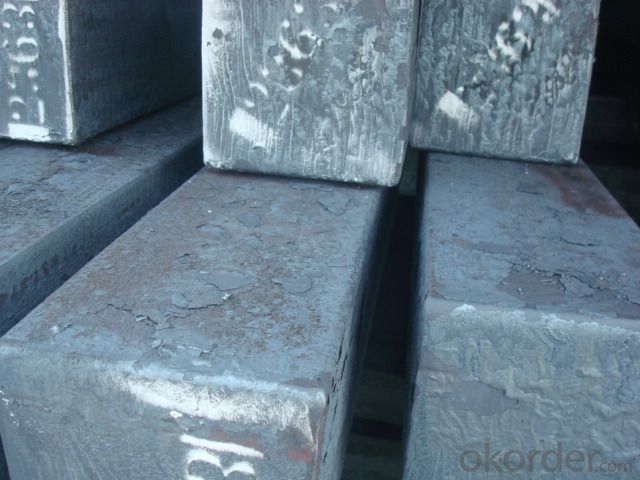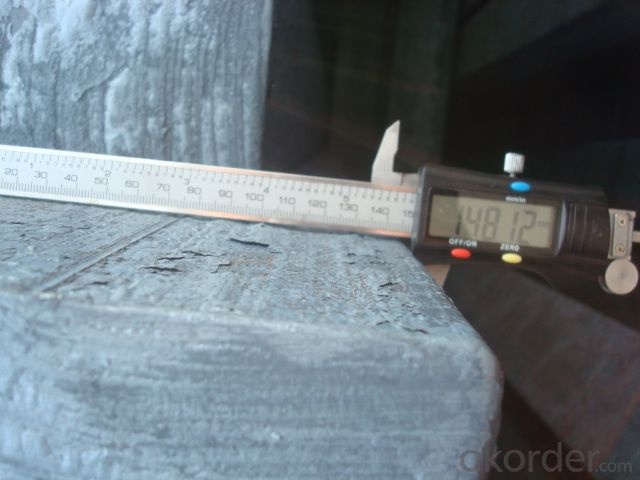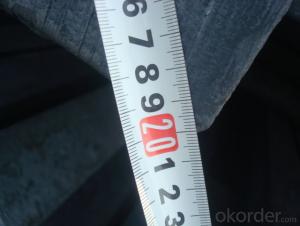Steel Billet Hot Rolled Q245 in Amazing Price
- Loading Port:
- Tianjin
- Payment Terms:
- TT OR LC
- Min Order Qty:
- 1000 m.t.
- Supply Capability:
- 50000 m.t./month
OKorder Service Pledge
OKorder Financial Service
You Might Also Like
1.Structure of Steel Billet
Steel billet(ingot) by cogging or breakdown of semi-finished products, is the raw material of all kinds of steel mill. Billet section of square, round, flat, rectangular and abnormity of several kinds of, mainly related to the shape of rolled products.
2.Main Features of Steel Billet
Rectangular billet continuous casting billet and mainly general carbon steel, low carbon low silicon cold-rolled material, high quality carbon structural steel, high strength low alloy steel, special steel, etc.
The billet is mainly divided into two kinds from the shape:
Slab: cross section width and height of the ratio of the larger, mainly used for rolling plate.
Billet: equal cross section width and height, or a huge difference, mainly used for rolling steel, wire rod. ,
Steel billets have distinct characteristics as compared with already furnished steel bars and products. Billets have a specific grain structure, which enables the metal to be processed more intricately. Steel billets are also known for their malleability and ductility, especially when exposed to varying temperatures during shaping and molding.
3.Processing of Steel Billet
Steel billets are considered fresh and raw, and they must undergo a series of manufacturing processes before they can be used for various purposes. Billets are made by means of freezing molten liquid, and are later exposed to extremely low temperatures in order to allow the metal to take shape and solidify in chemical structure. The temperature manipulates the metal's physical properties, and tones its strength and durability. The subsequent processes provide the metal's curved mold design so that it can fit the allotted space provided by other machines, which complete the finishing procedures.
4.Steel Billet Images


5. Steel Billet Specification
Hot rolled billet steel
Size: 50x50mm-180x180mm
Steel Grade: 3SP, 5SP,Q195,Q235,Q255,Q275 Length:3m-12m
MOQ: 1000MT/size
Payment term: TT or LC
Packing: in bulk , bundle
Shipment: by container , bulk vessel
Packaging Details: bundles with steel strips or as customers's requirements
Delivery time: 15-30 days after the deposit
Loading port:Tianjin, or other port China
Origin :China
Inspection:Third party inspection before loading.
6.FAQ
We have organized several common questions for our clients,may help you sincerely:
1) How about your company?
A world class manufacturer & supplier of castings forging in carbon steel and alloy steel,is one of the large-scale professional investment casting production bases in China,consisting of both casting foundry forging and machining factory. Annually more than 8000 tons Precision casting and forging parts are exported to markets in Europe,America and Japan. OEM casting and forging service available according to customer’s requirements.
2)Do you have your own QC department?
Yes, we have, our QC department will inspect the goods during the process of mass production and after completion of production.
3) Can you guarantee the quality of mass production?
Yes, of course. We will send pre-production samples to you for confirmation, after your confirmation we will start mass production. The quality of mass production will be the same as the samples you confirmed to us.
- Q:What are the different types of steel billet cutting tools?
- There is a wide variety of steel billet cutting tools to choose from, each designed with specific purposes and applications in mind. Some of the most commonly used types are: 1. Bandsaws: These cutting tools employ a continuous loop of toothed blade to effectively cut through steel billets. Bandsaws offer versatility, as they can handle both straight and curved cuts. 2. Circular saws: Featuring a rotating toothed blade, circular saws are known for their speed and efficiency in cutting steel billets. They are a popular choice for large-scale cutting operations. 3. Abrasive cut-off saws: These tools utilize a high-speed rotating abrasive disc to quickly cut through thick and hard steel billets. They are particularly useful when speed is of the essence. 4. Plasma cutters: By utilizing a high-velocity jet of ionized gas, plasma cutters can effortlessly melt and cut through steel billets. They are widely recognized for their precision and ability to handle thick materials. 5. Waterjet cutters: By employing a high-pressure jet of water mixed with abrasive particles, waterjet cutters can accurately cut through steel billets. They are especially suitable for cutting heat-sensitive materials since they do not generate heat. 6. Laser cutters: Laser cutters use a powerful laser beam to melt and vaporize steel, resulting in a precise and clean cut. They are renowned for their accuracy and versatility. These examples represent just a fraction of the available steel billet cutting tools. Choosing the appropriate tool depends on various factors, including the type and thickness of the material, desired precision, and specific application requirements.
- Q:What is the typical weight of a steel billet?
- The typical weight of a steel billet can vary depending on the specific dimensions and requirements, but it is commonly found to range between 1,000 to 5,000 kilograms or 2,205 to 11,023 pounds.
- Q:How are steel billets used in the production of crankshafts?
- Crankshafts rely on steel billets for their production, as these billets are essential in forming the foundation of this intricate component. Obtained through continuous casting or rolling of molten steel, steel billets are semi-finished products typically found in square or rectangular shapes. To create a crankshaft, the initial step involves heating the steel billet to a specific temperature, usually achieved through induction heating. This process enhances the billet's malleability, making it easier to shape. Once heated, the billet is placed into a forging machine, where it undergoes a series of compressive forces and plastic deformation. This gradual transformation results in the desired shape of the crankshaft. Throughout the forging process, the steel billet experiences immense pressure to ensure the metal grain structure aligns optimally. This alignment enhances the strength and durability of the crankshaft. Precise shaping of the crankshaft's main bearing journals, crankpin journals, and counterweights is achieved through carefully controlled forging techniques. Following the forging process, the partially finished crankshaft undergoes various machining operations, such as milling, turning, and grinding. These operations refine the crankshaft's dimensions and surface finish to meet the required specifications for smooth operation and efficient power transmission. In conclusion, steel billets are crucial raw materials in the production of crankshafts. Through the forging process, these billets are transformed into strong and resilient crankshafts capable of withstanding the demanding conditions of engines. The use of steel billets contributes to the production of crankshafts with superior strength, durability, and performance, making them vital components in the automotive and machinery industries.
- Q:What are the main challenges in the storage of steel billets?
- The main challenges in the storage of steel billets include maintaining proper environmental conditions, managing space efficiently, ensuring safety measures, preventing corrosion, and minimizing material damage. Firstly, the storage area should be maintained at a controlled temperature and humidity to prevent the steel billets from being exposed to extreme weather conditions, which could lead to rusting, oxidation, or other forms of corrosion. Adequate ventilation is also necessary to prevent the buildup of moisture that could affect the quality of the billets. Secondly, managing space efficiently is crucial in steel billet storage. Billets are often stored in large quantities, so proper organization and stacking methods must be employed to maximize the storage capacity and facilitate easy access to individual billets when needed. Implementing effective inventory management systems can help prevent unnecessary handling and potential damage. Safety measures are another significant challenge in steel billet storage. Due to their heavy weight and potential for sharp edges, it is essential to ensure proper handling and storage procedures to avoid accidents or injuries. Adequate training for personnel and the use of appropriate lifting equipment are necessary to maintain a safe working environment. Corrosion prevention is a critical concern in steel billet storage. Applying protective coatings, such as oil or rust inhibitors, can help shield the billets from moisture and prevent oxidation. Regular inspections and maintenance routines are also necessary to identify and address any signs of corrosion promptly. Lastly, minimizing material damage is crucial in steel billet storage. Proper handling techniques, such as avoiding dropping or dragging the billets, should be followed to prevent deformation or surface damage. Using suitable packaging or padding materials during transportation and storage can also help protect the billets from scratches or other physical impacts. In conclusion, the main challenges in the storage of steel billets revolve around maintaining proper environmental conditions, efficient space management, ensuring safety measures, preventing corrosion, and minimizing material damage. By addressing these challenges effectively, the longevity and quality of the steel billets can be preserved, resulting in enhanced operational efficiency and customer satisfaction.
- Q:How are steel billets coated or painted?
- Steel billets can be coated or painted through several methods. One common technique is hot-dip galvanizing, where the billets are immersed in a bath of molten zinc. This process forms a protective zinc coating on the surface of the steel, preventing corrosion. Another method is electroplating, which involves the deposition of a thin layer of metal, such as zinc or nickel, onto the billets using an electric current. Additionally, steel billets can be painted using various coating systems, such as powder coating or liquid paint, to provide a decorative finish or additional protection against rust and environmental factors.
- Q:How are steel billets used in the production of wire rods?
- Steel billets are used in the production of wire rods as they serve as the initial semi-finished product that undergoes further processing. These billets are heated and then passed through a series of rolling mills, where they are transformed into wire rods of desired shapes and sizes. The rolling process helps to reduce the billet's cross-sectional area, elongate it, and improve its mechanical properties. Once the wire rods are produced, they can be further processed or used directly in various industries, such as construction, automotive, and manufacturing.
- Q:What are the main factors affecting the corrosion resistance of carbon steel billets?
- The main factors affecting the corrosion resistance of carbon steel billets are the composition of the steel, the presence of impurities or alloying elements, the surface condition and finish, the environment (including humidity, temperature, and exposure to corrosive agents), and the protective coatings or treatments applied to the billets.
- Q:What are the main surface finishes available for steel billets?
- The main surface finishes available for steel billets include mill finish, pickled and oiled (P&O), galvanized, painted, and coated finishes. Mill finish refers to the surface of the steel billet as it comes from the rolling mill, which is typically characterized by a rough and unfinished appearance. This finish is suitable for applications where aesthetics are not a priority, such as when the billets will be further processed or coated. Pickled and oiled (P&O) finish involves treating the steel billets with an acid solution to remove any mill scale or impurities, followed by applying a thin layer of oil to protect the surface from oxidation. This finish provides a clean and smooth surface, making it suitable for applications where a high-quality appearance is desired. Galvanized finish involves immersing the steel billets in a zinc bath to create a protective layer of zinc coating over the surface. This finish provides excellent corrosion resistance, making it ideal for outdoor applications or environments with high moisture or chemical exposure. Painted finish involves applying a layer of paint onto the surface of the steel billets. This finish offers both aesthetic appeal and protection against corrosion, as the paint acts as a barrier between the steel and the external environment. Painted finishes can be customized in terms of color and texture to suit specific requirements. Coated finishes involve applying a specialized coating onto the surface of the steel billets. These coatings can include epoxy, polyurethane, or other protective materials that provide enhanced corrosion resistance, chemical resistance, or heat resistance. Coated finishes are often used in industries such as automotive, construction, or oil and gas, where the billets are subjected to harsh conditions. Overall, the choice of surface finish for steel billets depends on the specific application requirements, including aesthetics, corrosion resistance, durability, and environmental factors.
- Q:What are the main challenges in the supply chain management of steel billets?
- There are several main challenges in the supply chain management of steel billets. 1. Demand fluctuations: The steel industry is highly sensitive to economic cycles and changes in global demand. Fluctuations in demand can lead to imbalances in the supply chain, causing excess inventory or shortages of steel billets. This uncertainty makes it challenging for supply chain managers to accurately forecast demand and optimize production and inventory levels. 2. Transportation and logistics: Steel billets are heavy and bulky, making transportation and logistics a major challenge. Efficient transportation networks need to be established to ensure timely delivery of steel billets to customers. Moreover, the handling and storage of steel billets require specialized equipment and facilities, which can add complexity and cost to the supply chain. 3. Supply chain visibility: Lack of visibility and transparency across the supply chain can lead to inefficiencies and delays. It is crucial for supply chain managers to have real-time information on inventory levels, production status, and transportation schedules. This enables them to make informed decisions and mitigate any potential disruptions in the supply chain. 4. Quality control: Maintaining consistent quality of steel billets throughout the supply chain is vital. Steel billets are often produced by different manufacturers, and variations in quality can occur. Supply chain managers need to implement robust quality control processes to ensure that only high-quality billets are delivered to customers. This may involve regular inspections, testing, and strict adherence to industry standards. 5. Sustainability and environmental concerns: The steel industry is under increasing pressure to reduce its carbon footprint and adopt sustainable practices. Supply chain managers face the challenge of implementing environmentally friendly processes and sourcing steel billets from suppliers that adhere to sustainable practices. This may involve evaluating the environmental impact of transportation methods, optimizing energy consumption during production, and ensuring responsible sourcing of raw materials. In summary, the main challenges in the supply chain management of steel billets include demand fluctuations, transportation and logistics, supply chain visibility, quality control, and sustainability concerns. Overcoming these challenges requires effective planning, collaboration with suppliers and customers, and the use of advanced technologies to improve visibility and optimize processes.
- Q:Are steel billets used in the manufacturing of oil and gas pipelines?
- Oil and gas pipelines are commonly manufactured using steel billets. These billets are semi-finished products that are created through continuous casting, a process that solidifies molten steel into a rectangular form. They are utilized as the initial material for various steel products, specifically pipes for the oil and gas sector. The manufacturing process for oil and gas pipelines involves multiple steps, one of which is the production of seamless or welded steel pipes. Steel billets are heated and then rolled into tubes or pipes through a procedure known as pipe making. In the case of seamless pipes, the heated billet is pierced to create a hollow shell, which is subsequently elongated and shaped into a pipe. On the other hand, welded pipes are formed by rolling and welding a flat steel plate to construct a tube. The utilization of steel billets in pipeline manufacturing is favored due to steel's outstanding mechanical properties, which include strength, durability, and resistance to corrosion. These attributes make steel an ideal material for pipelines that must endure high-pressure environments and harsh conditions. Moreover, steel billets can be tailored in terms of size, shape, and composition to satisfy the specific requirements of each pipeline project. To summarize, steel billets play a critical role in the production of oil and gas pipelines. They serve as the raw material that undergoes transformation into seamless or welded pipes, enabling the transportation of oil and gas over long distances. The use of steel guarantees the dependability and integrity of these pipelines, establishing them as indispensable components of the oil and gas industry.
1. Manufacturer Overview |
|
|---|---|
| Location | |
| Year Established | |
| Annual Output Value | |
| Main Markets | |
| Company Certifications | |
2. Manufacturer Certificates |
|
|---|---|
| a) Certification Name | |
| Range | |
| Reference | |
| Validity Period | |
3. Manufacturer Capability |
|
|---|---|
| a)Trade Capacity | |
| Nearest Port | |
| Export Percentage | |
| No.of Employees in Trade Department | |
| Language Spoken: | |
| b)Factory Information | |
| Factory Size: | |
| No. of Production Lines | |
| Contract Manufacturing | |
| Product Price Range | |
Send your message to us
Steel Billet Hot Rolled Q245 in Amazing Price
- Loading Port:
- Tianjin
- Payment Terms:
- TT OR LC
- Min Order Qty:
- 1000 m.t.
- Supply Capability:
- 50000 m.t./month
OKorder Service Pledge
OKorder Financial Service
Similar products
New products
Hot products
Hot Searches
Related keywords






























